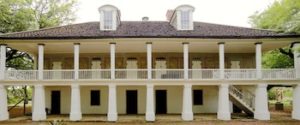
The Whitney Plantation
*On this date in 1752, the Whitney Plantation is affirmed. It is located in Wallace, Louisiana, one of the estimated 46,200 American plantations in 1860.
The plantation was started by white German immigrants Ambroise Haydel and his wife, and their descendants owned it until 1867. The French Creole-raised-style main house, built in 1803, is the most important architectural example in the state. The plantation has numerous outbuildings or "dependencies": a pigeoneer or dovecote, a plantation store, the only surviving French Creole barn in Louisiana, and slave quarters. The quarters were moved from another plantation but are typical of those originally on Whitney. The complex includes three archaeological sites which have had varying degrees of exploration.
The 1884 Mialaret House and its associated buildings and property were added to the complex by a later purchase. They help to reflect the long working history of the plantation. Some of the lands are still planted with sugarcane. The Whitney Plantation historic district was listed on the U.S. National Register of Historic Places in 1992 and is devoted to slavery in the Southern United States. The district, including the main house and outbuildings, is preserved near St. John the Baptist Parish, Louisiana, on the River Road along the Mississippi River.
It is one of 26 sites featured on the Louisiana African American Heritage Trail. The plantation is a 2,000-acre property and opened to the public for the first time in December 2014. It was founded by John Cummings, a trial attorney from New Orleans who has spent more than $8 million on this long-term project and worked on it for nearly 15 years. The research director is Dr. Ibrahima Seck, a Senegalese scholar specializing in the history of slavery.
The grounds contain imaginative exhibits and original art commissioned by Cummings, such as life-size sculptures of children. The sculptures represent people born into slavery before the Civil War, many of whom were interviewed as adults for the Federal Writers Project during the Great Depression. These oral histories of hundreds of the last survivors of American slavery were collected and published by the federal government to preserve their stories. The Library of Congress holds the transcripts and some audio recordings. Scenes from the 2012 film Django Unchained were filmed on and around the plantation. The Atlantic magazine made a short documentary video about the museum in 2015, Why America Needs a Slavery Museum.